The Holly Guide
Holly plants (genus Ilex) are evergreen and deciduous shrubs and trees known for their glossy foliage, ornamental berries, and diverse growth habits. With species ranging from compact mounding shrubs to upright screen-forming trees, hollies are a foundational element in gardens and landscapes across North America. Their versatility, durability, and multi-season interest make them ideal for everything from formal hedging to naturalistic wildlife plantings.
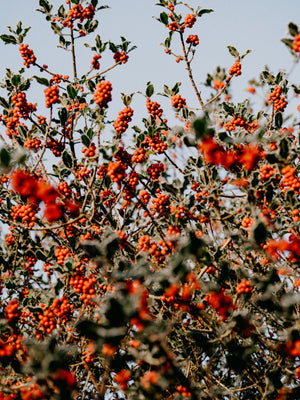
About
The Ilex genus includes more than 400 species, but in landscape use, hollies are generally grouped into four main categories: evergreen English-type hollies (Ilex aquifolium), Japanese hollies (Ilex crenata), native American hollies (Ilex opaca and Ilex glabra), and deciduous winterberry hollies (Ilex verticillata).
Evergreen hollies like Ilex x meserveae ‘Blue Princess’ and ‘China Girl’ are prized for their dark green, spiny leaves and red berries that persist through winter. Native species such as Ilex opaca (American holly) are long-lived trees with exceptional wildlife value and stately forms. Ilex crenata, or Japanese holly, features small, spineless leaves and is commonly used as a boxwood alternative for low hedges and foundation plantings. Ilex glabra, or inkberry holly, is another boxwood substitute, native to the eastern U.S., known for its tolerance to wet soils and softer appearance.
Winterberry (Ilex verticillata) is a deciduous holly that loses its leaves in fall but holds onto brightly colored berries all winter. Cultivars like ‘Winter Red’, ‘Berry Heavy’, and ‘Red Sprite’ are excellent for seasonal color and native bird support.
From narrow vertical growers like ‘Sky Pencil’ to broad-spreading groundcovers like ‘Maryland Dwarf’, the holly genus provides solutions for nearly every design challenge.
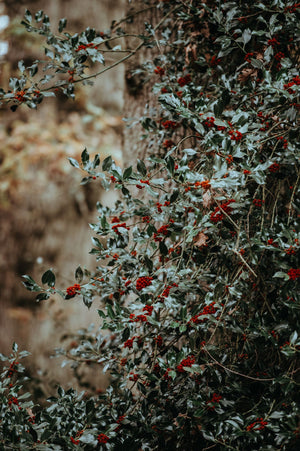
PLANTING
With the right placement and soil conditions, hollies thrive and deliver beauty across all seasons.
USDA Hardiness Zones:
- Japanese hollies (Ilex crenata): Zones 5–8
- Inkberry (Ilex glabra): Zones 4–9
- American holly (Ilex opaca): Zones 5–9
- Winterberry (Ilex verticillata): Zones 3–9
- Hybrid hollies (Ilex x meserveae): Zones 5–9
Soil: Hollies prefer moist, well-drained, slightly acidic soil rich in organic matter. Winterberries and inkberries tolerate wetter soils. Avoid alkaline or poorly drained clay without soil amendments.
Sunlight: Most hollies prefer full sun to partial shade. Evergreen hollies need full sun for best berry production and dense foliage. Winterberry and inkberry can tolerate more shade but may fruit less heavily.
Watering: Hollies need regular watering during the first year. Once established, most are moderately drought-tolerant, though winterberry and inkberry perform best in consistent moisture.
Planting Time: Best planted in spring or early fall to allow roots to establish in moderate temperatures.
Spacing:
- Dwarf types like ‘Helleri’ and ‘Drops of Gold’: 2–3 feet apart
- Upright forms like ‘Sky Pencil’, ‘Castle Spire’, or ‘Jersey Pinnacle’: 3–5 feet apart
- Large shrubs or trees like Ilex opaca or ‘Nellie R. Stevens’: 10–15 feet apart
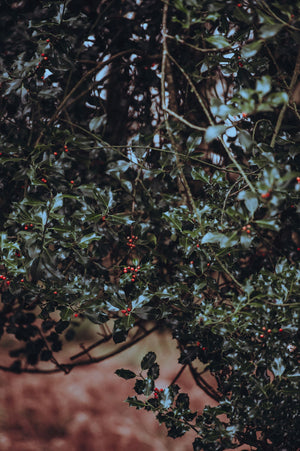
CARE
Most hollies are low-maintenance, long-lived, and benefit from seasonal pruning and regular watering when young.
Watering: Water deeply and consistently during the first two years. Maintain moderate moisture, especially in sandy soils.
Fertilizing: Use a balanced, slow-release fertilizer formulated for acid-loving plants in early spring. Avoid over-fertilizing, which can reduce berry production or cause excessive leaf growth.
Pruning: Prune in late winter or early spring before new growth emerges. Shaping can also be done in early summer. Hollies respond well to shearing, particularly Japanese types used as hedges. For berry production, avoid heavy pruning after flowering.
Pests & Diseases: Hollies are generally pest-resistant but can occasionally experience leaf spot, spider mites, or scale. Good air circulation and proper spacing minimize issues.
Mulching: Mulch 2–3 inches deep to retain moisture and suppress weeds. Keep mulch away from the trunk or base of the shrub to prevent disease.
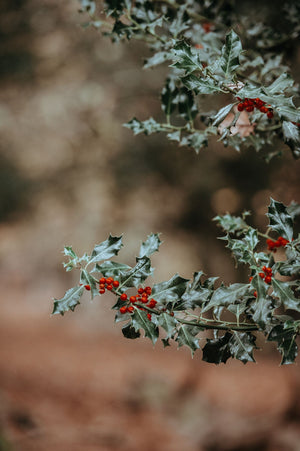
HOW TO USE
Holly’s structural presence, evergreen color, and winter berries make it one of the most versatile and useful groups of plants in landscape design. From privacy screens to compact accents, hollies offer year-round function and visual impact.
Focal Point: Bold upright varieties like ‘Dragon Lady’, ‘Castle Spire’, and Ilex opaca ‘Satyr Hill’ make strong vertical accents and formal focal points in gardens. Their dark green foliage and red berries stand out against snow, fences, or foundation walls and hold form year-round.
Hedges and Screens: For evergreen privacy, hollies are among the best options available. Use Ilex x meserveae cultivars (‘Blue Princess’, ‘China Girl’, ‘Nellie R. Stevens’) or American holly for dense, tall screens. For low hedges, Japanese holly types like ‘Steeds’, ‘Hoogendorn’, and ‘Compacta’ offer boxwood-like form with better disease resistance.
Foundation Plantings: Compact selections like ‘Soft Touch’, ‘Helleri’, and ‘Drops of Gold’ are ideal for foundation beds and walkways. Their fine texture and manageable size make them easy to maintain and shape.
Winter Interest and Berry Displays: Female hollies with bright red, orange, or gold berries provide color and structure in the cold months. Combine ‘Winter Red’ or 'Afterglow’ with male pollinators like ‘Southern Gentleman’ or ‘Jim Dandy’ to ensure heavy berry set.
Pollinator and Wildlife Gardens: Native hollies like Ilex glabra and Ilex verticillata support a variety of wildlife, including native bees, birds, and butterflies. Berry-producing hollies provide winter food for songbirds and migratory species.
Rain Gardens and Wet Sites: Inkberry holly (Ilex glabra) is ideal for damp or periodically flooded areas. It makes a dense, durable hedge or mass planting that tolerates wet feet better than most evergreens.
Mixed Borders: Hollies are excellent anchors in mixed borders. Pair them with hydrangeas, fothergilla, and ornamental grasses for contrast in color, texture, and seasonal display.
Containers and Courtyards: Dwarf hollies like ‘Schwoebel’s Upright’ can be used in large containers for formal entrances or courtyard gardens. Their slow growth and evergreen presence offer structure without frequent pruning.
Native and Restoration Gardens: Use American holly, inkberry, or winterberry in native plantings, riparian zones, and restoration projects where ecological benefits and long-term structure are needed.
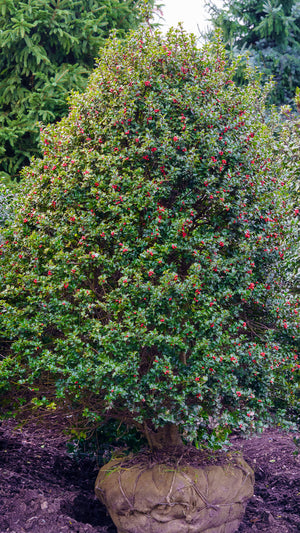
Common Questions
Are holly berries poisonous? Yes. Holly berries are mildly toxic to humans and pets if ingested, causing nausea, vomiting, or diarrhea. While not typically life-threatening, berries should be kept out of reach of children and animals.
Does holly need pruning? Pruning is not required but helps maintain shape and size. Most hollies respond well to light shearing or selective pruning in late winter or after flowering.
What is the shape of a holly plant? Forms vary widely. Hollies may be upright pyramidal (e.g., ‘Blue Maid’), rounded and compact (e.g., ‘Soft Touch’), columnar (e.g., ‘Sky Pencil’), or prostrate and spreading (e.g., ‘Maryland Dwarf’).
Does holly need fertilizer? Hollies benefit from yearly feeding with an acid-based fertilizer, especially in poor soils. Over-fertilization should be avoided to prevent leggy growth.
When to prune holly bushes? Late winter or early spring before new growth appears is best. Pruning after flowering preserves berry production on female plants.
Are holly poisonous to dogs or cats? Yes. Holly leaves and berries are mildly toxic to dogs and cats and can cause digestive upset. While serious toxicity is rare, ingestion should be avoided.
Do deer eat holly? Some hollies, especially those with spiny leaves like Ilex opaca and Ilex x meserveae, are moderately deer-resistant. However, softer-leaved species may be browsed in winter if food is scarce.
Do rabbits eat holly? Rabbits generally avoid holly due to its tough leaves and spines, but young plants may be vulnerable during harsh conditions.
Do holly plants need full sun? Holly performs best in full sun to partial shade. More sun typically leads to better berry production and denser growth, though inkberry and winterberry tolerate more shade than other species.
How tall does holly grow? Growth height varies by species and cultivar. Dwarf forms may stay under 3 feet, while large varieties like Ilex opaca and ‘Nellie R. Stevens’ can reach 20 to 30 feet tall or more at maturity.
Conclusion
Holly is a cornerstone of the four-season landscape, offering structure, evergreen beauty, and ornamental berries that last through winter. With a range of forms, colors, and species to choose from, hollies provide solutions for privacy, color, wildlife support, and formal design. Whether you're creating a naturalized border, a formal hedge, or a colorful focal point, there’s a holly for every garden.
The Holly Collection
Sold Out
Sold Out

